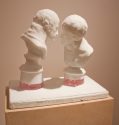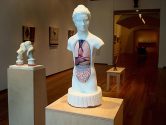“Last Call: Stephen Paul Day at Arthur Roger Gallery,” Pelican Bomb
Self-loving, self-reflexive, or perhaps self-deprecating, Stephen Paul Day’s “Blame It On Vegas: Collecting Meta-Modern” offers many opportunities for similarly complicated readings. As both curator and artist, Day forms the exhibition’s thesis by creating and gathering an odd variety of objects from historically and geographically distant places. These objects share a palette of white, bronze, and pastels but the harmony ends there. Wavering between humor and novelty, with a hint of disgust, the viewer is taxed with making sense of Day’s assemblage of the “metamodern.”



